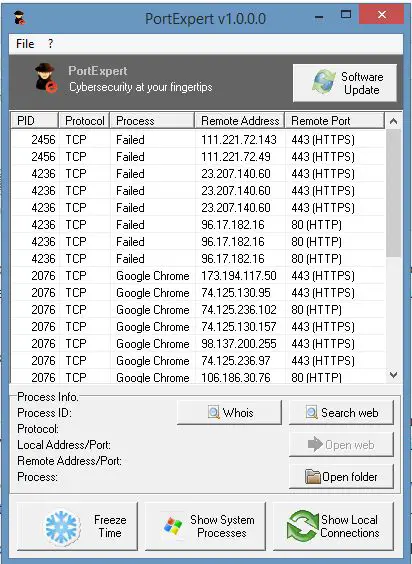PortExpert is a free application that can give very useful information about all TCP, UDP communications connected to the system and is hence useful to identify potential threats. These days we are hearing of many hacking stories, where millions of computers are being compromised by malware. Monitoring TCP/UDP traffic can help a user protect their computer from active threats. They can check all active connections that are trying to connect to the internet or send receiving packets.
PortExpert checks for open TCP or UDP ports that can be used by hackers to perform malicious activity on the system. A computer user must check for threats, viruses, or open ports, and they should run scans on a timely basis to detect and remove those threats from their computer.

Monitor TCP, UDP Ports
When a user launches PortExpert, they will see a list of all TCP or UDP ports which are active and connected with their remote IP address. A user can double-click on any such active connection to dig further and learn more about that connection. The Freeze Time option can be used further to deactivate any connection.
The whois, feature can be used to learn more about the IP address location. It will open whois.domaintools.com website when an IP address is selected from the pool of active connection. By clicking on Search Web feature, a user can learn more about the current process which is currently accessing the internet using an active TCP/UDP connection.
The Show System Process, is another option using this user can check current active ports used by OS files. Show Local Connection will open current active UDP port connection and a user can select any such running process and read the basic information about the process ID and the Protocol (TCP, UDP) it is using to connect, local address, and remote address with the port number.
netstat command
Users can also check the active connection using Windows in-built command line. To see all active network connections, open a command prompt window, type netstat and hit Enter. This command will show you the active TCP connections and ports with the physical computer name. Type netstat /? to list down all commands along with the task description.
Using netstat -n command will show TCP connections and ports with numerical or IP address instead of computers or service’s actual name. netstat -a and netstat -b are other few commands that can help users to check various active connections.
PortExpert free download
Go get it from it home page. Remember to download the Lite installer or the Portable version as otherwise you may be offered bundled software.